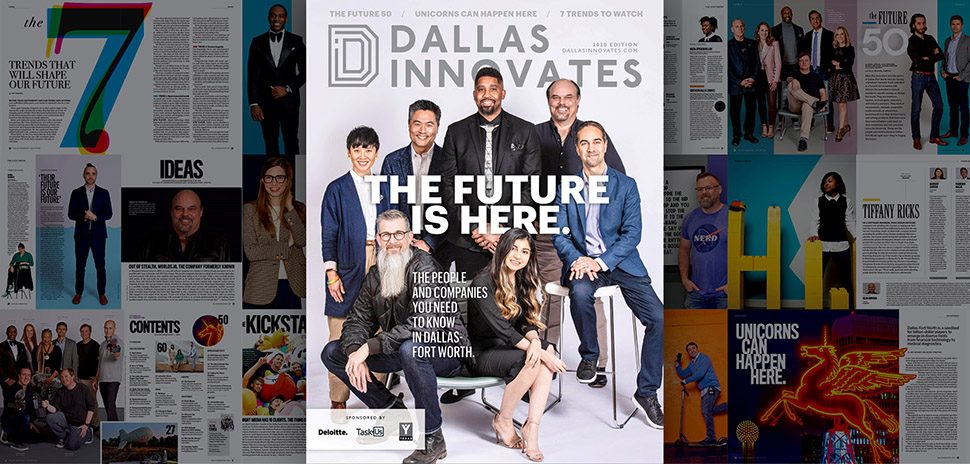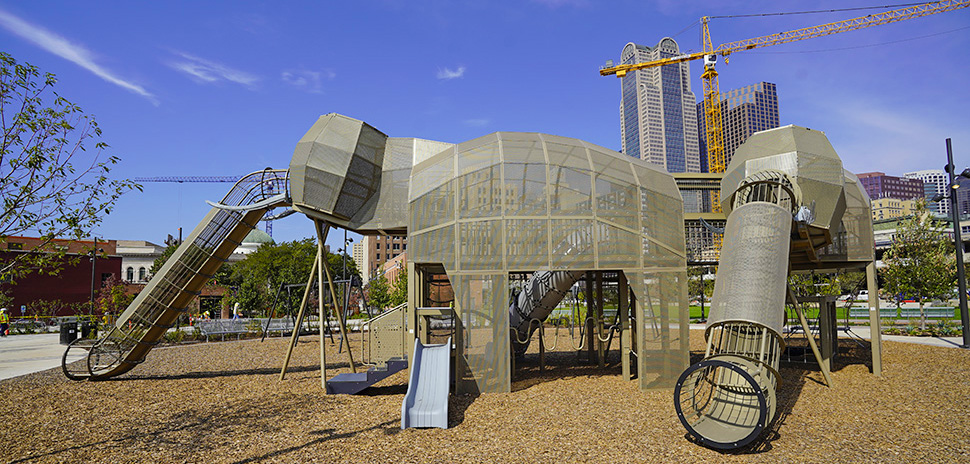At long last, a vision is coming to life in what could be a crown jewel near downtown Dallas—and a river runs through it.
The Trinity Park Conservancy unveiled plans this week for the $325 million Harold Simmons Park—a 250-acre park along a stretch of the Trinity River close to downtown. A game-changing river park has long been a dream for the city, but since voters approved an initial plan in 1998, making it a reality has proved elusive.
Tony Moore, CEO of the Trinity Park Conservancy, addressed that in his opening remarks about the park’s planned groundbreaking in 2024.
“When I first got to Dallas. I heard a lot of different conversations that this park has been in the works for 10 years, 20 years, even 100 years,” Moore said. “And the park we have today is significantly different than the park that we initially started with. But nevertheless, this is an exciting time for us.”
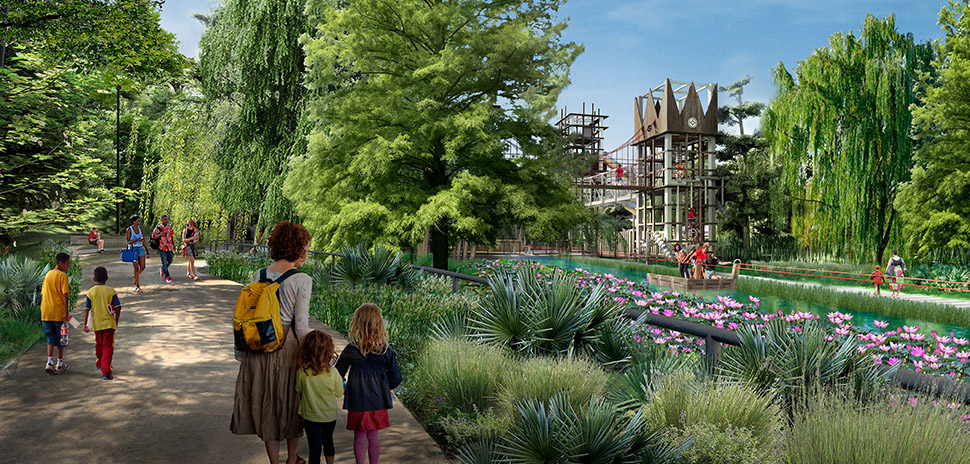
Rendering of Harold Simmons Park. [Image: Trinity Park Conservancy]
“Building green infrastructures in a built environment is a highly complex job that requires a lot of different pivoting and adjustments and acquiring the land, the right location that’s suitable for a park, and working with the community in ensuring this park resonates with the community,” Moore noted. “And working with a city and all the civic entities from a funding point of view and from a support point of view.”
“But the Harold Simmons Park today is well positioned, and we’re excited to share with you this unveiling.”
Before he did, he thanked Gail Thomas, the former CEO of the Trinity Trust, and Mary Cook, former chair of the Trinity Trust, as well as Brent Brown, his predecessor as CEO of the conservancy, “for all the hard work that we’re able to build on.”
Overlooks on the levees—with the river as ‘the heart of our park’
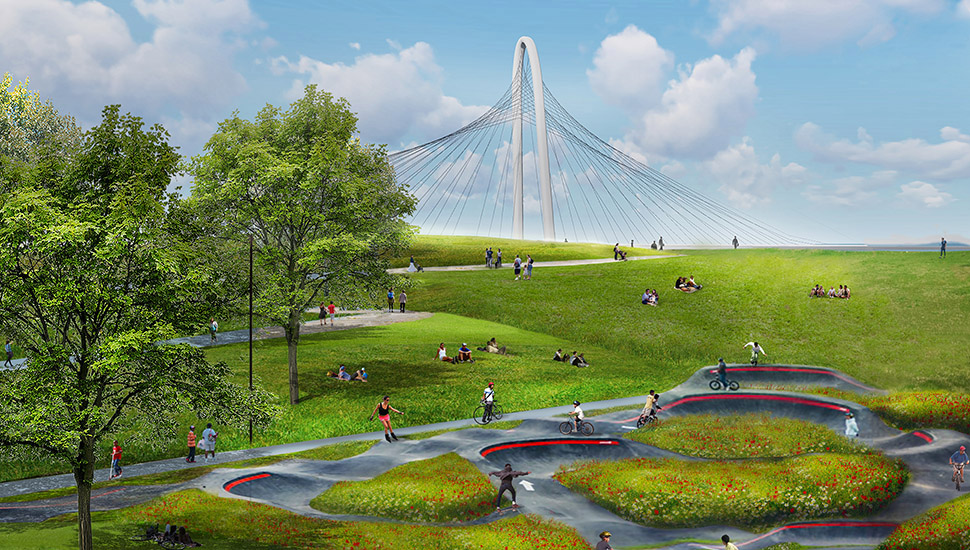
Rendering of Harold Simmons Park with bike and skate park in foreground. [Image: Trinity Park Conservancy]
Harold Simmons Park—named after the late billionaire businessman whose wife, Annette Simmons, donated $50 million for the park in 2016—will be located between the Margaret McDermott Bridge and Ronald Kirk Bridge just west of downtown Dallas. The Trinity winds its way past downtown with large levees keeping it in check on both sides—creating a vital flood plain overseen by the Army Corps of Engineers, which has long resisted plans to alter what’s between the levees.
“Regardless of what you may have heard, the river and the green floodway is the very heart of our park,” Moore said. ” When the time is appropriate, we will incorporate that in our park plans. The Army Corps of Engineers are hard at work and they’re adjusting the levees all along the Trinity River, and their job from flood safety mitigation is public safety. After what happened with [Hurricane] Katrina and [Hurricane] Harvey, they’re doing meaningful flood mitigation safety work. We’re excited when the time comes and the Corps gets to the area centralized around our park and how this will evolve. But the river is a major part—and we’re excited with the type of programming that the greenway will offer for Dallas.”
In fact, the river’s greenway and its future “nature preserves” will account for 200 of the park’s 250 acres. The other 50 acres—and for now, the key destinations imagined for the park—will feature a series of “overlooks” that crest the levees on either side.
Matt Urbanski, a partner with the park’s designer, Michael Van Valkenburgh Associates, said those overlooks will be part of what brings the city together.
“There’s this connection to the region—and to the east and west sides of the city—that this space is ripe and ready to deliver,” Urbankski said during the announcement. “Our idea is to create these overlooked parks around the edges of the floodway and bring people right up to it and right up to the top of the levee and connect them to the to the floodway—and therefore allow the river and the greenway to become this joiner instead of a divider.”
San Antonio-based architecture firm Lake Flato is also working on the park, designing a two-story event pavilion and other buildings.
‘Where nature meets Dallas’—with up to 6 million visitors a year
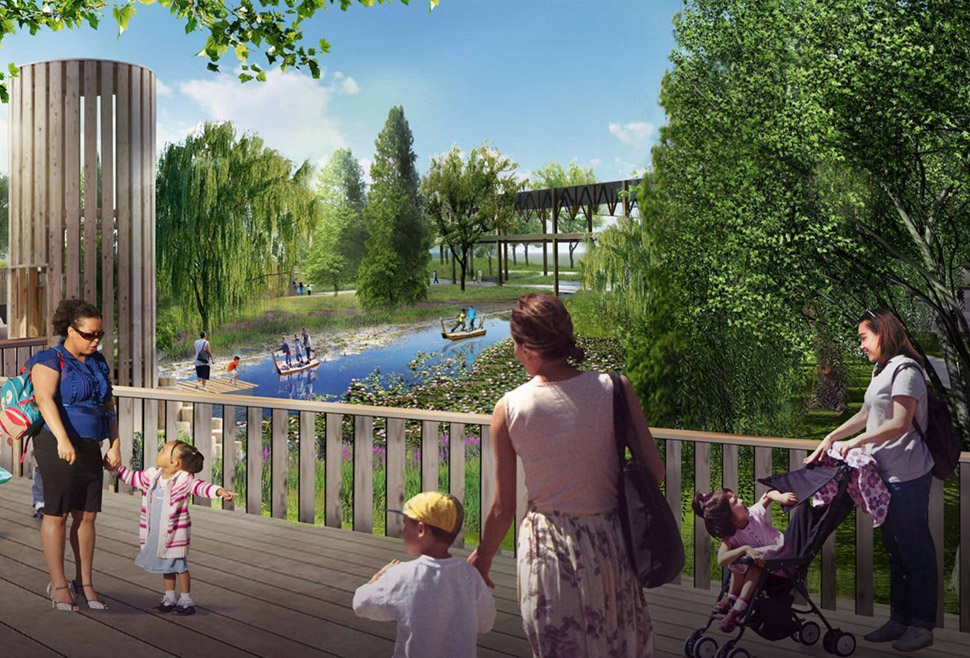
Rendering of a “play cove” at Harold Simmons Park. [Image: Trinity Park Conservancy]
“This is a park that will be heavily focused on nature with our tagline, ‘Where nature unites Dallas,'” Moore said.
And that natural uniting of West Dallas, Oak Cliff, and downtown Dallas could lead to some big numbers. Moore said the park will have an estimated economic impact of $6 billion over 30 years, with a forecasted annual attendance between 4 to 6 million visitors a year.
“This will be a significant game changer for Dallas,” he said, noting that voters recently approved another big nearby game-changer: a major expansion of the Kay Bailey Hutchison Convention Center Dallas as part of a $1.2 million master plan. “Conventioneers will be excited about a park that’s literally a short walk away,” he predicted.
The project’s first build will be the West Overlook, encompassing around 22 acres. North of the West Overlook is the Felix Lozada Gateway—an additional six acres named after the late barber and baker who advocated tirelessly on behalf of West Dallas.
Two acres on the Ron Kirk Bridge will be incorporated in the park, and the Continental Gateway on the park’s East Overlook will connect the park to the Katy Trail.
South of the Continental Gateway will be a combination of 20 acres that lead to Reunion Tower.
‘Adding to the cultural attractions of Dallas’
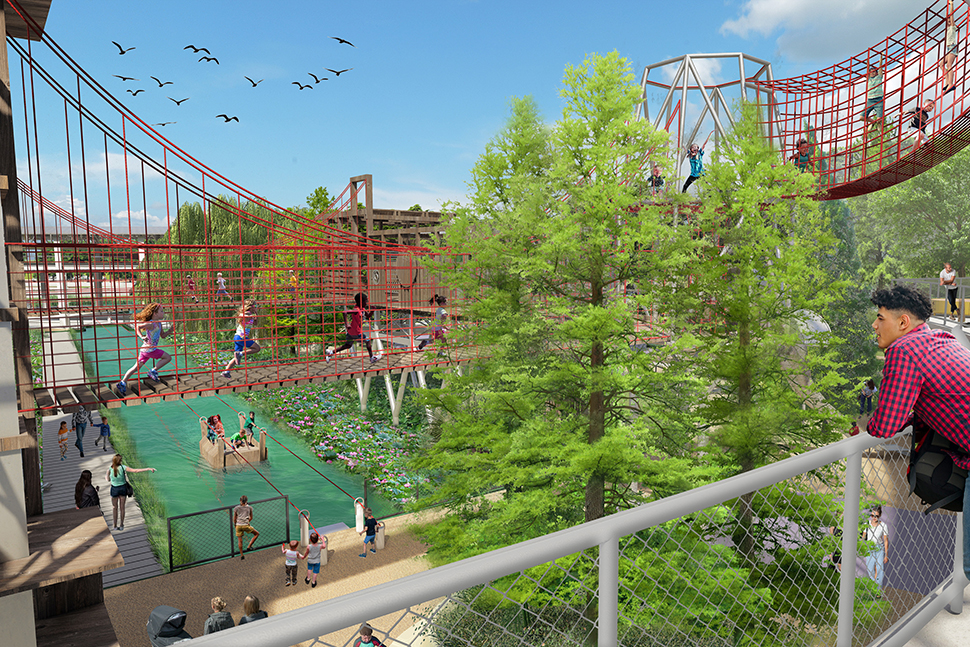
Rendering of a planned playground at Harold Simmons Park. [Image: Trinity Park Conservancy]
The conservancy has big plans for what the park can offer to Dallas beyond its natural settings.
“This is a park that will be significantly impactful in adding to the cultural attractions of Dallas,” Moore said.
The West Overlook alone will be divided into 20 different “unique experiences.” There will be a playground with six towers and four slides (as seen above and at the top of this article). An event lawn just shy of an acre will be the site of “massive events and cultural festivals,” with the ability to host over 3,000 visitors at a time.
A large shed structure currently used by Contractors Iron and Steel “will be reimagined” and used in multiple ways—from flea markets to community engagements, fresh food markets, education classes, and art crawls.
“We’re not just building a park,” said Deedie Rose, board chair of the Trinity Park Conservancy. “We’re transforming a city.”
A two-acre bike and skate park
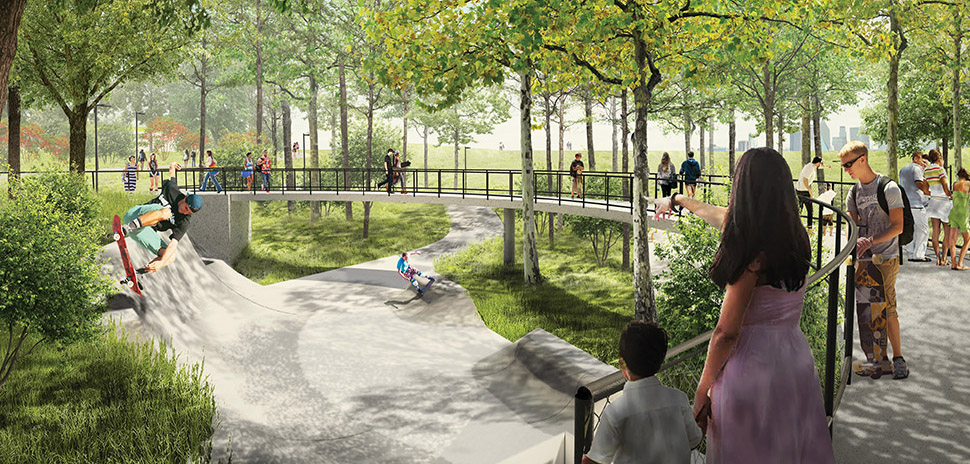
Rendering of part of the two-acre bike and skate park at Harold Simmons Park. [Image: Trinity Park Conservancy]
One key attraction will be a two-acre bike and skate park—”the largest in Dallas”—which will be sited close to the Commerce Street bridge. There will also be a dog park and two sand volleyball courts that will overlook at the Trinity overview, Moore said. A lawn will offer a place of respite to look across at the downtown skyline as well as the nature preserves below.
A “prairie walk” will showcase a combination of wildflowers—with 280 parking spots nearby to help visitors get to all these things.
‘Water factory’ will offer both fun and irrigation
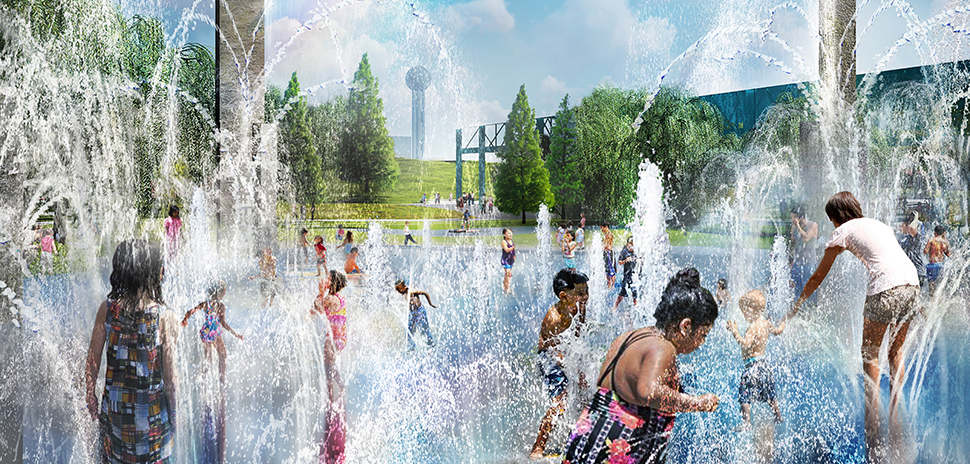
Rendering of a splash pad which will be part of the “water factory” at Harold Simmons Park. [Image: Trinity Park Conservancy]
Kids and green thumbs alike will want to know about this feature.
“We’ll have a community-led and a community-designed ‘water factory’—which is a splash pad for cooling down in which the water that’s used for splashing will also be reused for irrigation for our plants,” Moore said, moving into the planned greenery elements of the park.
“We have over 1,500 trees that will help to mitigate the heat island impact, over 3,000 shrubs and over 100,000 plants,” he said of the plan. “And in addition to that, a ‘picnic grove’ for gatherings of our community, along with several buildings.”
Mayor: ‘A greener and greater Dallas for all’
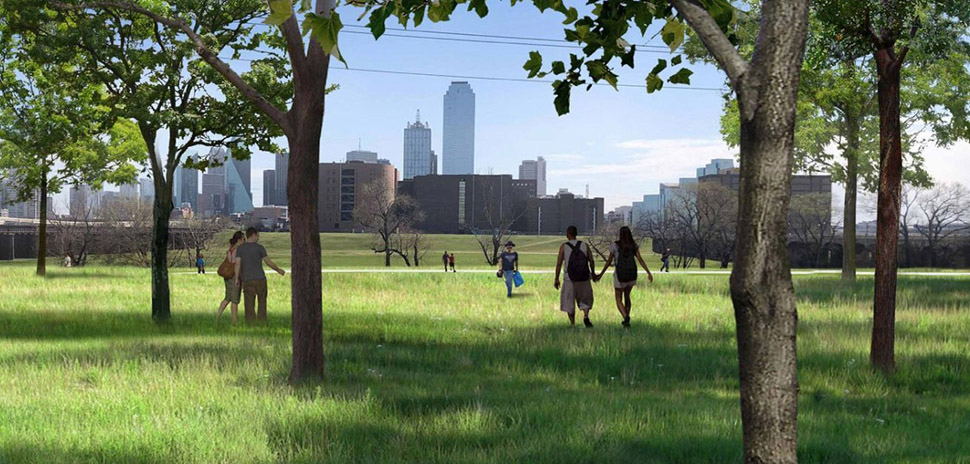
Rendering of the “overlook lawn” at Harold Simmons Park. [Image: Trinity Park Conservancy]
Mayor Eric Johnson offered his perspective for the conservancy announcement.
“Dallas loves its parks,” the mayor said. “It has become a national model for excellence in developing innovative green spaces. Harold Simmons Park will transform the Trinity River core. This project supports a bigger dream with a dream of a greener and greater Dallas for all. I’m thrilled to watch this vision come to life.”
Omar Narvaez, council member for District 6, focused on the “connectivity” the park will bring across the levees to downtown the Design District. “Everything now that’s happening around there is making sure we connect it to this park,” he said, “which is going to be one of the grandest parks, not just in Dallas, but across the entire state of Texas and the nation.”
‘The calling card for Dallas’
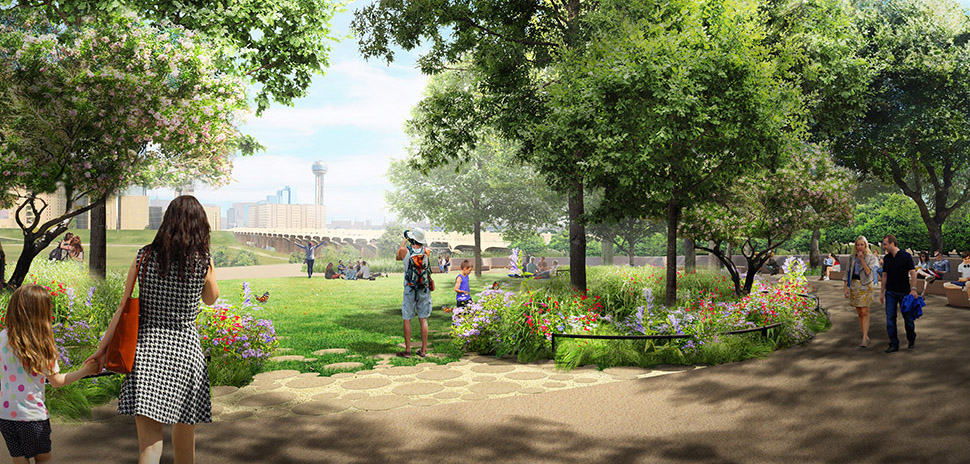
Rendering of Harold Simmons Park with part of the Dallas skyline in distance. [Image: Trinity Park Conservancy]
Marguerite Hoffman, vice chair of the Trinity Park Conservancy, said she believes the park “will become the calling card for Dallas.”
“I think not only did we enhance the natural attributes of our city, but we did it with intention with the help of the communities around it,” she said. “That’s something that’s pretty noteworthy.”
Vincent T. Parker, chair of the Trinity River Corridor Local Government Corporation, agreed by saying the park represents “a recreational piece that can bridge the divide. It offers an opportunity to see healthy growth and development for neighborhoods that have been neglected for so long.”
Getting there will take “a collaborative effort,” said Marcus Shropshire, director of capital projects for the Trinity Park Conservancy. “We’re going to be working with the city of Dallas and the Army Corps of Engineers to local trade industries from all construction sectors to bring Harold Simmons Park to fruition,” he said.
Time as a ‘curator of excellence’
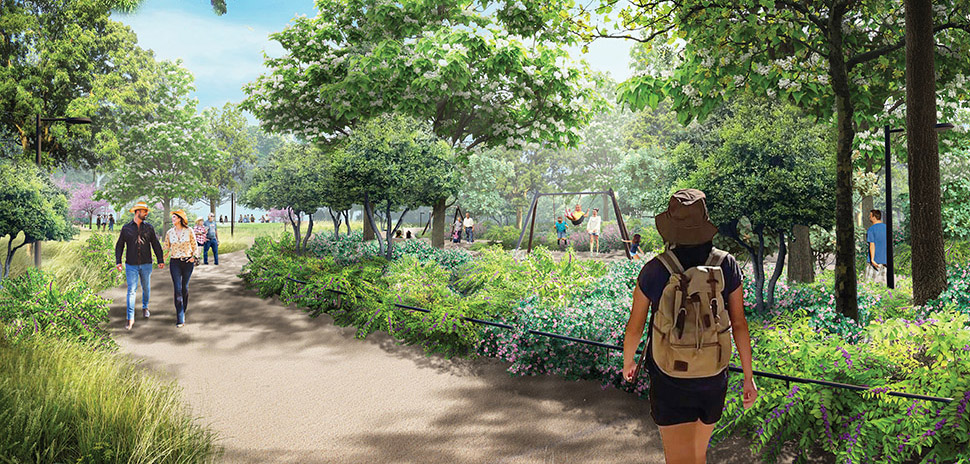
Rendering of Harold Simmons Park. [Image: Trinity Park Conservancy]
So, after remaining a dream for decades. what will all that time bring to the park’s groundbreaking next year?
“I’m a true believer that time sometimes is a curator of excellence,” Moore said. “The Harold Simmons Park is a park for all, regardless of your age, race, socioeconomics, or your zip code—where nature will unite the cities and communities of Dallas.”
More looks at Harold Simmons Park
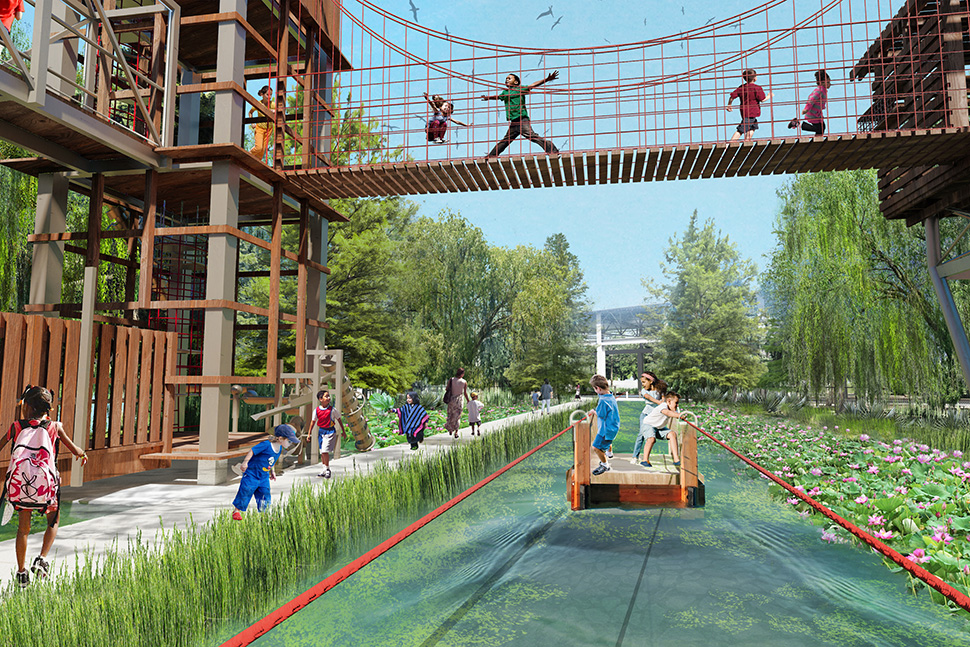
Kid heaven: another rendering of a planned playground at Harold Simmons Park. [Image: Trinity Park Conservancy]
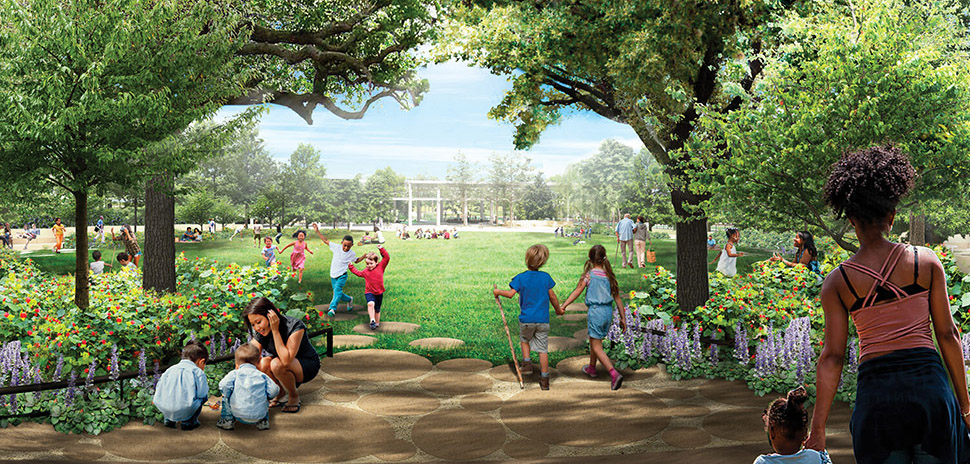
Rendering of Harold Simmons Park. [Image: Trinity Park Conservancy]
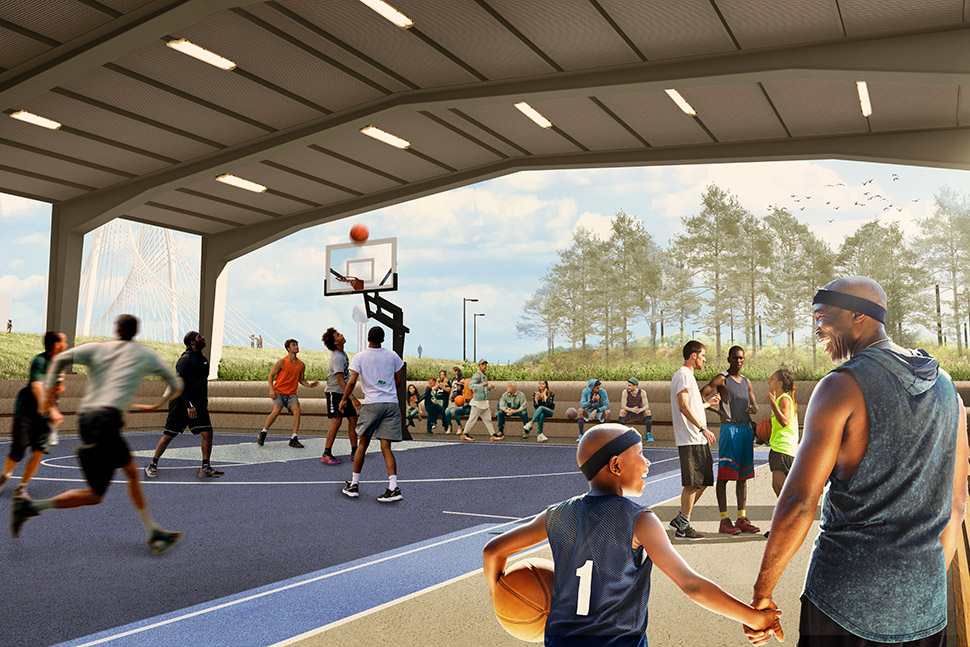
Shooting hoops in Harold Simmons Park. [Rendering: Trinity Park Conservancy]
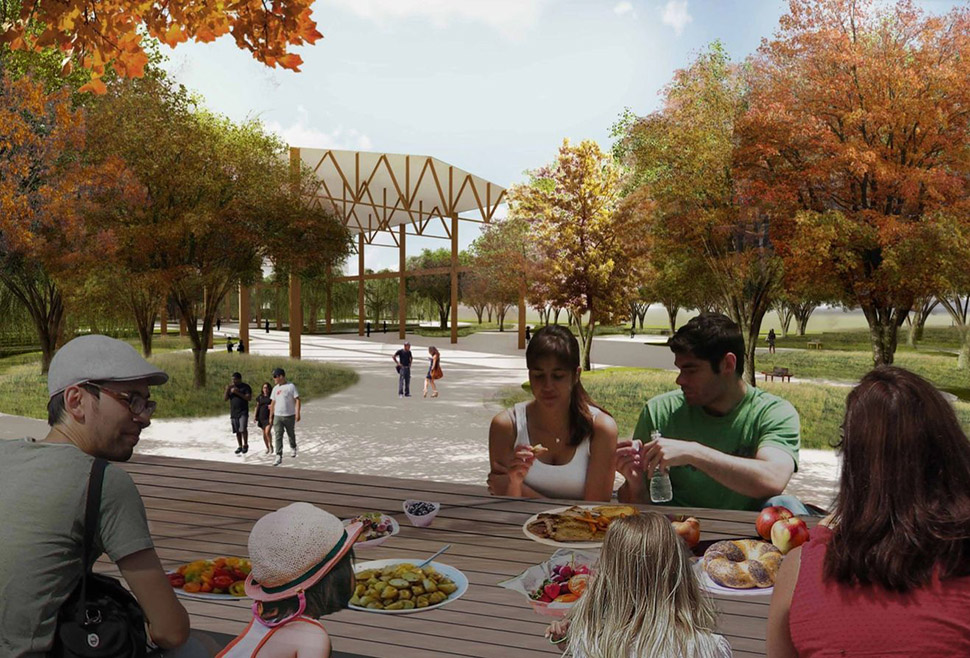
Hey, you gotta eat. Rendering of picnic area at Harold Simmons Park. [Image: Trinity Park Conservancy]
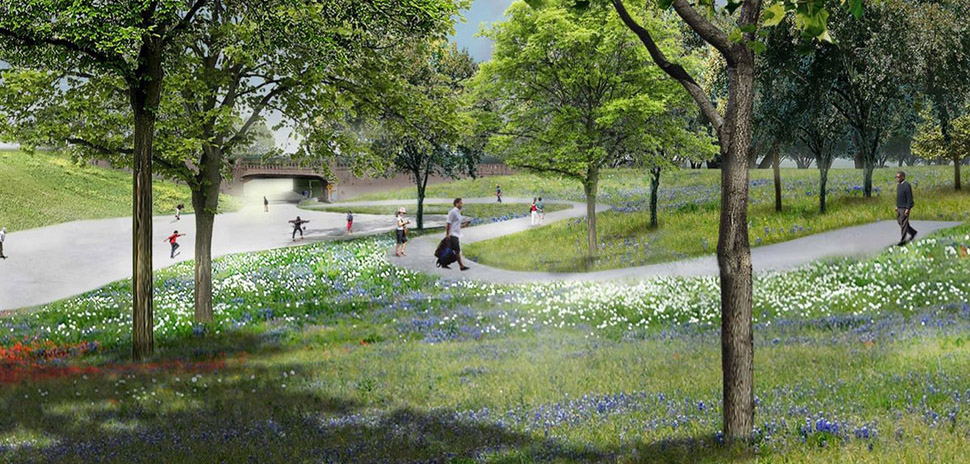
Rendering of the “prairie walk” at Harold Simmons Park. [Image: Trinity Park Conservancy]
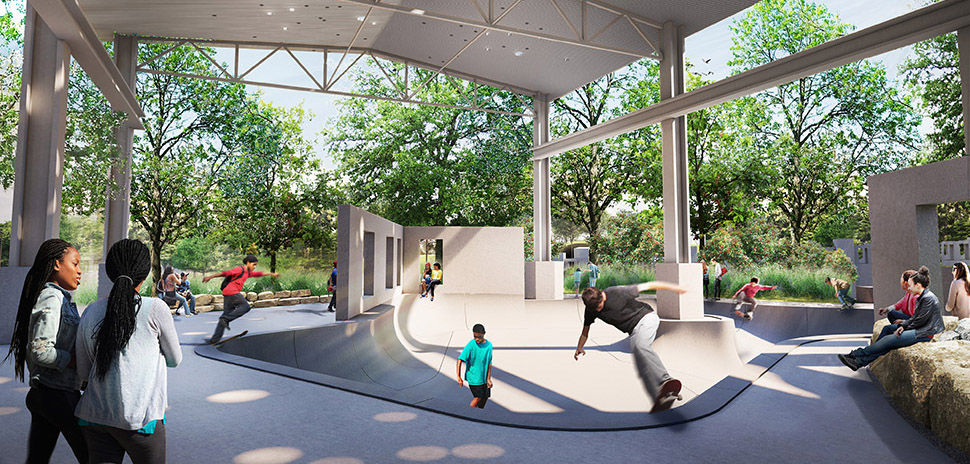
Rendering of part of the sprawling skate park at Harold Simmons Park. [Image: Trinity Park Conservancy]
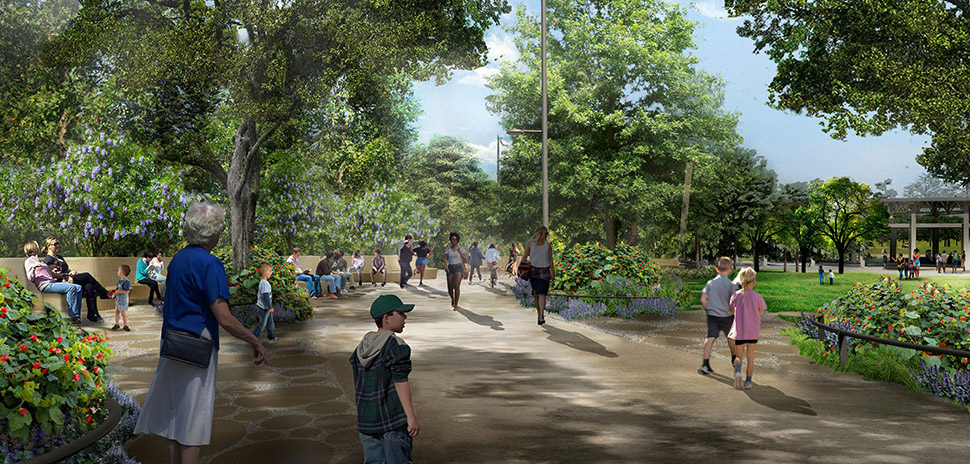
Rendering of Harold Simmons Park. [Image: Trinity Park Conservancy]
![]()
Get on the list.
Dallas Innovates, every day.
Sign up to keep your eye on what’s new and next in Dallas-Fort Worth, every day.




